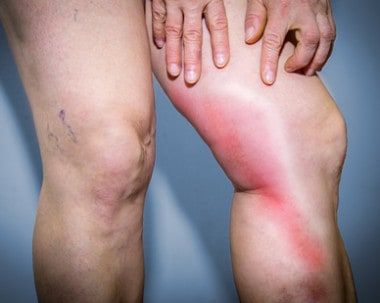Symptoms and treatment of phlebitis
Phlebitis is a painful condition that is usually associated with varicose veins. Thrombophlebitis, as the medical term is, is an inflammation of superficial blood vessels, which may be accompanied by fever.
Although it is not a dangerous disease, those affected feel a great deal of suffering due to the pain that occurs. In mild cases, the phlebitis heals within a few days. If the condition is more severe, the healing process may take several weeks to complete.
Characteristic symptoms of phlebitis
Characteristic symptoms of phlebitis are reddening of the skin in the affected area. The area is usually noticeably warmer than the surrounding skin and there is severe pain.
As the blood vessels swell in response to the inflammation, they can sometimes be felt under the skin. Particularly in the case of mechanical stimuli, such as those caused by the contraction of muscles or by touch, the pain is felt.
One of the most common causes of phlebitis is varicose veins. In this condition, blood outflow is impaired and congestion occurs in the vessels.
Under certain circumstances, an injury to the vascular wall can also lead to phlebitis. If bacteria penetrate through the opening, they can cause a corresponding inflammatory reaction.
The risk of developing thrombophlebitis is increased if the blood is more prone to clotting.
Treatment of mild phlebitis
In mild phlebitis, usually only superficial blood vessels are affected. Nevertheless, the advice of a medical specialist should be sought in order to exclude varicose veins as the cause. Usually an ointment with anti-inflammatory ingredients is applied to the affected area and a bandage is applied.
Sometimes the doctor prescribes exercise therapy to stimulate the circulation. Painkillers are used as support, since the movement initially intensifies the pain. Depending on the consistency of the blood, anticoagulant drugs are used.
Treatment of varicose vein disease
People who suffer from phlebitis at regular intervals in particular should consult a doctor to determine whether varicose vein disease is a possible cause. In this case, treatment with anti-inflammatory ointments does not bring long-term success. Surgery is often the last resort for sufferers.
Surgery puts a permanent end to the suffering and is usually performed on an outpatient basis. During this procedure, the diseased vessel is removed. The body functions are not affected by this measure in any way, because the return transport of blood to the heart is taken over by healthy veins from this point onwards.
With the surgical removal of varicose veins, the risk of contracting phlebitis is reduced to a minimum and affected individuals experience a significant increase in quality of life.
